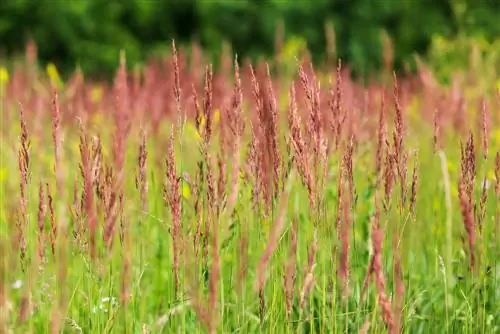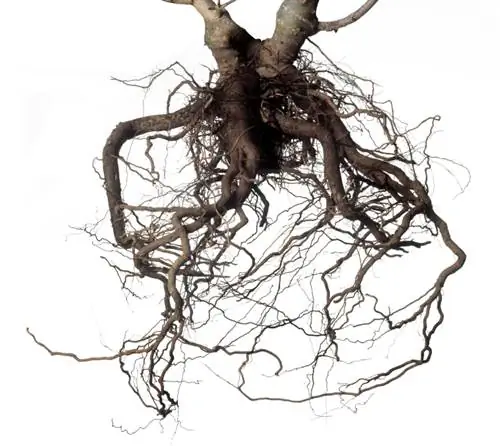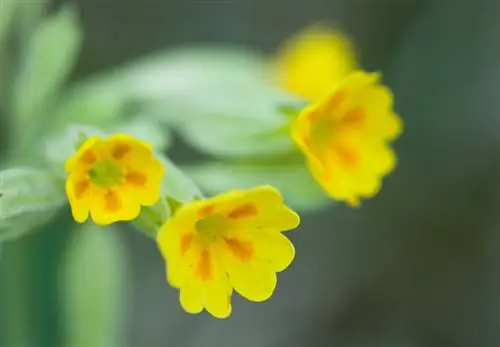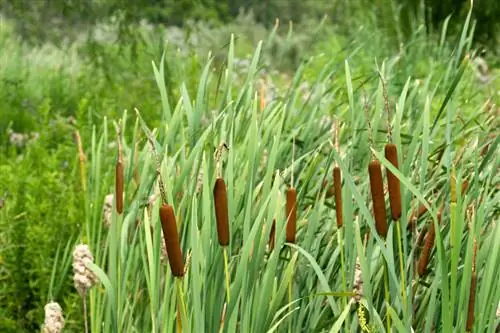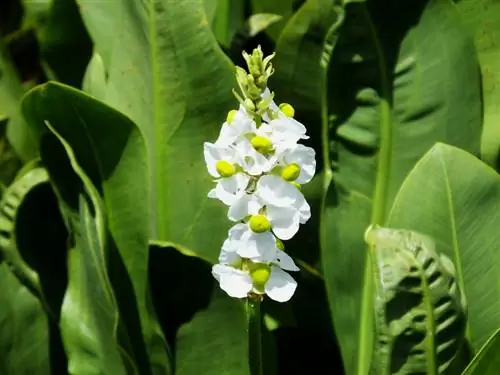- Author admin [email protected].
- Public 2023-12-16 16:46.
- Last modified 2025-01-23 11:22.
Read a commented red fescue profile here. An overview of important subspecies of the red fescue group. The best tips for sowing and caring for Festuca rubra in the hobby garden.
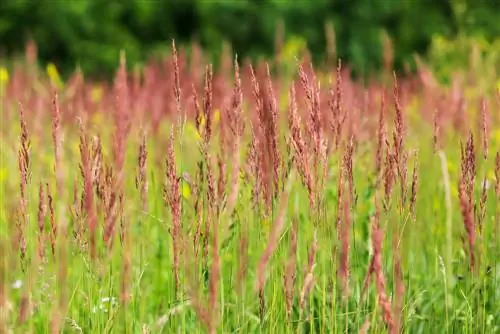
What is red fescue and where is it found?
Red fescue (Festuca rubra) is a hardy sweet grass found in Europe, Asia and North America. It is often used in lawn mixtures because it is fine-leaved, densely growing and undemanding. The subspecies of the red fescue group vary in height and growth form, including common red fescue, runner red fescue, clump red fescue and hairy red fescue.
Profile
- Scientific name: Festuca rubra agg.
- Collection type: Red fescue group
- Family: Sweet grasses (Poaceae)
- Occurrence: Europe, Asia, North America
- Growth type: Grass
- Growth habit: clumpy, stoloniferous
- Growth height: 20 cm to 80 cm
- Leaf: elongated-narrow, smooth-edged, grooved
- Flower: panicle
- Roots: Rhizomes with or without runners
- Winter hardiness: hardy
- Uses: ornamental lawn, landscape lawn, fodder grass
Growth
Red fescue is an important component of seed mixes for lawns and agriculture. No other sweet grasses thrive as finely leafed, densely bushy, even and undemanding as the subspecies of the red fescue group. The following overview summarizes significant key growth data:
- Tightly upright, stiff stalks with lanceolate, narrow stem leaves and feather-light spike flowers.
- Depending on the subspecies, runner-forming, loose-grassy, regenerative or clumpy and densely growing.
Regardless of the different growth, red fescue impresses as a hardy, perennial ornamental grass with modest requirements in terms of climate, soil quality and nutrient supply.
Red Fescue Group
The different subspecies of the red fescue group are divided into the categories 'stoloniferous' and 'host-forming'. This criterion largely determines the best possible use of red fescue as a lawn, grassland carpet, meadow or forage grass. The following table provides an overview:
| Subspecies | Common Red Fescue | Red fescue runners | horstrot fescue | Hairleaf Red Fescue |
|---|---|---|---|---|
| Botanical name | Festuca rubra L. | Festuca rubra rubra | Festuca rubra commutata | Festuca rubra trichophylla |
| Synonym | Bulrush red fescue | Runner Fescue | Festuca nigrescens | Red fescue with short runners |
| Growth height | 15 cm to 100 cm | 20 cm to 80 cm | 20 cm to 90 cm | 30 cm to 70 cm |
| Growth | foothills | foothills | horstforming | weakly branching |
| Usage | + Grassland facility | + utility lawn | + Ornamental lawn | + Ornamental lawn |
| + Feeding meadow | + Landscape Lawn | + Golf turf | + Playing turf | |
| + poor grassland | + Herbal lawn | + Landscape Lawn | + utility lawn | |
| + Shadow lawn | + Flower meadow | + Herbal lawn | + Flower meadow |
With the two sweet grasses perennial ryegrass (Lolium perenne) and meadow panicle (Poa pratensis), red fescue (Festuca rubra) forms the dream team for many premium quality lawn varieties. In the following video you will get an insight into the effective synergy effects when these sweet grasses combine in seed mixtures:
Video: The three most important lawn grasses in comparison - perennial ryegrass, red fescue and meadow panicle
Leaf
Slender leaf blades that sprout from the leaf sheaths grow on the tightly upright stalks. These characteristics characterize the leaf of a red fescue:
- Leaf blade: narrow to thread-like, distinctively grooved with 5 to 7 grooves.
- Leaf sheaths: almost completely closed (in contrast to the collecting species sheep fescue)
- Special feature: young leaf sheaths in a sunny location have a reddish tint, later yellowish-brown.
- Leaf base: short ligules, no ears in the transition from the leaf sheath to the leaf blade.
- Leaf color: light green to gray-green
Bloom
In summer, loosely branched inflorescences rise above red fescue grass. These spikes dangle casually from their own tall stems. It is the sheer number of delicate spikelets in the cluster that gives the red fescue a fluffy, bushy appearance, lawnmower and scythe permitting:
- Inflorescences: upright, double racemes with 2 to 3 spikelets each
- Spikelets: 10 mm long, unawned, reddish in color when flowering.
- Flowering time: April to October
- flower ecology: hermaphrodite
- Pollination: Wind
Excursus
Corn benefits from red fescue undersowing
Sowing red fescue as undergrass for sweet corn has real advantages. Soil life also finds vital food in winter. Furthermore, the quality of the soil improves and important nutrients accumulate for subsequent crops after the corn harvest. Last but not least, red fescue grass as undersown prevents destructive erosion and instead promotes the build-up of humus. Hobby gardeners and farmers alike benefit from these advantages.
Planting red fescue
Red fescue grass is ideal for sowing as a lawn or meadow. In this respect, Festuca rubra differs from other sweet grasses, such as the majestic switchgrass (Panicum virgatum), which present themselves as solitary plants or as privacy screens. The following lines sum up where and how to sow red fescue correctly:
Location
Red fescue is an important lawn and undergrass for all unfavorable locations where ryegrass (Lolium perenne) and meadow panicle (Poa pratensis) fail. Hardy, germinative and tolerant of cutting, Festuca rubra thrives undiminished under these site conditions:
- Sunny to semi-shady location (also tolerates shade in damp locations).
- Understanding to heat, moisture and wind exposure.
- Ideally nutrient-poor soil, barren and calcareous.
If a location offers an abundance of nutrients, red fescue is usually crowded out by other grasses.
Sowing
The correct sowing of red fescue grass does not require any expert knowledge. A two-stage soil preparation every 14 days generates ideal starting conditions for seeds and seedlings. The following short instructions explain the correct procedure:
- The best sowing dates are from the end of April to the beginning of June and from mid-September to the beginning of October.
- 2 weeks before sowing, dig the soil to a depth of 30 cm, incorporate sand, weed, rake and water.
- While the seed soil is settling, do not walk on the area, sprinkle when it is dry.
- For the fine subgrade, rake the seedbed, weed, roll and smooth again.
Pour the red fescue seeds into a spreader (€23.00 on Amazon) and set the spreading rate to 25 g/m². Walk the area in a checkerboard pattern to ensure even sowing. Finally, the seedbed is rolled and watered thoroughly.
Special case: poor lawn with red fescue
Natural hobby gardeners have banished monotonous lawns from the garden and are creating a lean lawn, herb lawn or a wildflower meadow. In the sunny location, regional natural beauties such as red fescue (Festuca rubra commutata), yarrow (Achillea), sage (Salvia), meadow bluebell (Campanula patula), chartreuse carnation (Dianthus carthusianorum) and meadow clover (Trifolium pratense) gather to form a playground for bees, bumblebees, beetles and butterflies.
For planting, dig the area to a depth of 50 cm. Fill the pit to a depth of 40 cm with gravel and grit. Spread a 10 cm thin layer of topsoil and sand over this as a fine subsoil for sowing.
Care for red fescue
Even frugal red fescue grass requires a minimum of care. Regular watering and cutting as well as correct fertilization are important for a lush green, dense and durable green area. The care program is rounded off with annual scarifying, occasional sanding and liming for a representative red fescue carpet at eye level with an English lawn. Care tips worth knowing for hobby gardeners:
- Watering: When dry, water the red fescue grass area thoroughly (10-15 liters per m²)
- Cutting: mowing the lawn once or twice a week from spring to autumn at a blade height of 4-5 cm.
- Fertilization: do not fertilize pure red fescue green areas, fertilize mixed green areas in March and June.
- Dethatching: Scarify mossy red fescue lawns after the first mowing.
- Sanding: sand the scarified lawn with fine-grained quartz sand (1 bucket of sand per m²).
- Limen: if the pH value is less than 5, lime the lawn.
At the end of the season, devote yourself again to red fescue care and make the green area winter-proof. To increase frost tolerance, apply a potassium-rich autumn fertilizer or spray the grass area with comfrey manure. Make the final cut after the first ground frost. Winter care is limited to regular sweeping of leaves.
Skinny lawn care tips
One of the many advantages of natural dry grass with red fescue is low-maintenance care:
- Do not fertilize poor lawns, herb lawns and wildflower meadows.
- Water once a week in summer when there is prolonged drought.
- Scythe or mow twice per season, ideally in July and September.
Popular varieties
These red fescue varieties are available from specialist retailers as seeds:
- Barlineus: clump-forming, slow-growing, fine-leaved, dense turf, ideal for playing and sports turf.
- Spice: runner-producing, good weed displacement, quickly closes gaps in the turf.
- Gondolin: forms underground runners, very short leaf cuticles, grazing-resistant undergrass for fresh, nutrient-poor locations.
- Rafael: Festuca rubra variety with high stigma density and early budding, recommended by the Bavarian State Institute for Agriculture.
- Reverent: resistant to rust tipping, medium late sprouting, medium grain density.
FAQ
How can red fescue be recognized?
Red fescue is easily recognizable by its fine, bristly, distinctively grooved leaves and stiff stalks. The leaves are threadlike to narrow with a maximum width of 1.5 mm. The turf-forming leaf blades of the basal leaves are folded. If you look closely, you can see very short leaf cuticles. The name red fescue refers to the young, reddish leaf sheaths, which turn yellowish-brown over the course of the year. In the transition from leaf sheaths to leaf blades, red fescue grass does not form ears.
What feed value does red fescue grass have?
Red fescue grass is certified to have an average feed value of FWZ 5. In agriculture, Festuca rubra is grown where the conditions are delicate. Red fescue thrives in rough, nutrient-poor locations and tolerates drought and acidic soil. These advantages primarily make common red fescue an important grass for the cultivation of meadows and pastures when other forage grasses fail, such as perennial ryegrass and meadow panicle with a feed value of FWZ 8.
What significance does red fescue have for the lawn in the natural garden?
Red fescue is important for lawns and nature for several reasons. For this reason, both growth forms are included in every good seed mix. The clump-forming subspecies are valued for their fine leaves and robust tolerance to frequent lawn mowing and unfavorable soil qualities. The runner-growing fescue subspecies score points with their talent for closing unsightly gaps in the turf in no time. In short: As an important seed component, red fescue grass gives every lawn support and density in harmony with nature.
Can you buy red fescue as a potted plant for the perennial bed?
Chorus fescue (Festuca rubra commutata) has made a name for itself as an important component in seed mixtures. The sweet grass is not offered in pots, like the other subspecies of the red fescue group. As an alternative, we recommend switching to comparable fescue species. Sheep fescue (Festuca amethystina 'Aprilgrün') is available as a pot plant in tree nurseries and garden centers. A popular gap filler in perennial beds and lean rock gardens is blue fescue (Festuca cinerea) with a height of 10-25 cm.
Which grasses should be included in a good variety of playing turf?
A look at the packaging of lawn seeds provides important information about quality and durability. Look for a wide range of varieties for a dense, robust turf. A recommended mixture contains the three subspecies of red fescue: red fescue (Festuca rubra commutata), red fescue (Festuca rubra rubra) and red fescue with short runners (Festuca rubra trichophylla). The original species are supplemented by 2 types of perennial ryegrass (Lolium perenne) and 2 types of meadow rape (Poa pratensis).

